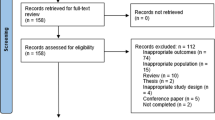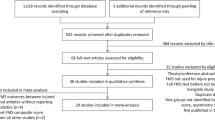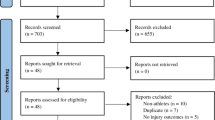Abstract
Subjective assessment of athletes’ movement quality is widely used by physiotherapists and other applied practitioners within many sports. One of the beliefs driving this practice is that individuals who display ‘poor’ movement patterns are more likely to suffer an injury than those who do not. The aim of this review was to summarize the reliability of the movement screens currently documented within the scientific literature and explore the evidence surrounding their association with injury risk. Ten assessments with accompanying reliability data were identified through the literature search. Only two of these ten had any evidence directly related to injury risk. A number of methodological issues were present throughout the identified studies, including small sample sizes, lack of descriptive rater or participant information, ambiguous injury definitions, lack of exposure time reporting and risk of bias. These factors, combined with the paucity of research on this topic, make drawing conclusions as to the reliability and predictive ability of movement screens difficult. None of the movement screens that appear within the scientific literature currently have enough evidence to justify the tag of ‘injury prediction tool’.


Similar content being viewed by others
References
Mendez-Villanueva A, Buchheit M. Football-specific fitness testing: adding value or confirming the evidence? J Sports Sci. 2013;31(13):1503–8.
McCall A, Carling C, Nedelec M, et al. Risk factors, testing and preventative strategies for non-contact injuries in professional football: current perceptions and practices of 44 teams from various premier leagues. Br J Sports Med. 2014;48(18):1352–7.
McGill S, Frost D, Andersen J, et al. Movement quality and links to measures of fitness in firefighters. Work. 2013;45(3):357–66.
Frost D, Andersen J, Lam T, et al. The relationship between general measures of fitness, passive range of motion and whole-body movement quality. Ergonomics. 2013;56(4):637–49.
van Mechelen W, Hlobil H, Kemper HC. Incidence, severity, aetiology and prevention of sports injuries. A review of concepts. Sports Med. 1992;14(2):82–99.
Cook G, Burton L, Hoogenboom BJ, et al. Functional movement screening: the use of fundamental movements as an assessment of function-part 2. Int J Sports Phys Ther. 2014;9(4):549–63.
Giblin S, Collins D, Button C. Physical literacy: importance, assessment and future directions. Sports Med. 2014;44(9):1177–84.
Cook G, Burton L, Hoogenboom BJ, et al. Functional movement screening: the use of fundamental movements as an assessment of function—part 1. Int J Sports Phys Ther. 2014;9(3):396–409.
Batterham AM, George KP. Reliability in evidence-based clinical practice: a primer for allied health professionals. Phys Ther Sport. 2003;4(3):122–8.
Atkinson G, Nevill AM. Statistical methods for assessing measurement error (reliability) in variables relevant to sports medicine. Sports Med. 1998;26(4):217–38.
Smith CA, Chimera NJ, Wright NJ, et al. Interrater and intrarater reliability of the functional movement screen. J Strength Cond Res. 2013;27(4):982–7.
Parenteau-G E, Gaudreault N, Chambers S, et al. Functional movement screen test: a reliable screening test for young elite ice hockey players. Phys Ther Sport. 2014;15(3):169–75.
Onate JA, Dewey T, Kollock RO, et al. Real-time intersession and interrater reliability of the functional movement screen. J Strength Cond Res. 2012;26(2):408–15.
Shultz R, Anderson SC, Matheson GO, et al. Test–retest and interrater reliability of the functional movement screen. J Athl Train. 2013;48(3):331–6.
Landis JR, Koch GG. The measurement of observer agreement for categorical data. Biometrics. 1977;33(1):159–74.
Terwee CB, Mokkink LB, Knol DL, et al. Rating the methodological quality in systematic reviews of studies on measurement properties: a scoring system for the COSMIN checklist. Qual Life Res. 2012;21(4):651–7.
Hotta T, Nishiguchi S, Fukutani N, et al. Functional movement screen for predicting running injuries in 18–24 year-old competitive male runners. J Strength Cond Res. 2015. [Epub ahead of print].
Gulgin H, Hoogenboom B. The functional movement screening (fms)™: an inter-rater reliability study between raters of varied experience. Int J Sports Phys Ther. 2014;9(1):14–20.
Letafatkar A, Hadadnezhad M, Shojaedin S, et al. Relationship between functional movement screening score and history of injury. Int J Sports Phys Ther. 2014;9(1):21–7.
Elias JE. The inter-rater reliability of the functional movement screen within an athletic population using untrained raters. J Strength Cond Res. 2013. [Epub ahead of print].
Gribble PA, Brigle J, Pietrosimone BG, et al. Intrarater reliability of the functional movement screen. J Strength Cond Res. 2013;27(4):978–81.
Frohm A, Heijne A, Kowalski J, et al. A nine-test screening battery for athletes: a reliability study. Scand J Med Sci Sports. 2012;22(3):306–15.
Klusemann MJ, Pyne DB, Fay TS, et al. Online video-based resistance training improves the physical capacity of junior basketball athletes. J Strength Cond Res. 2012;26(10):2677–84.
Teyhen DS, Shaffer SW, Lorenson CL, et al. The functional movement screen: a reliability study. J Orthop Sports Phys Ther. 2012;42(6):530–40.
Butler RJ, Plisky PJ, Kiesel KB. Interrater reliability of videotaped performance on the functional movement screen using the 100-point scoring scale. Athl Train Sports Health Care. 2012;4(3):103–9.
Schneiders AG, Davidsson A, Hörman E, et al. Functional movement screen normative values in a young, active population. Int J Sports Phys Ther. 2011;6(2):75–82.
Chorba RS, Chorba DJ, Bouillon LE, et al. Use of a functional movement screening tool to determine injury risk in female collegiate athletes. N Am J Sports Phys Ther. 2010;5(2):47–54.
Minick KI, Kiesel KB, Burton L, et al. Interrater reliability of the functional movement screen. J Strength Cond Res. 2010;24(2):479–86.
Frost DM, Beach TA, Callaghan JP, et al. FMS™ scores change with performers’ knowledge of the grading criteria—are general whole-body movement screens capturing “dysfunction”? J Strength Cond Res. 2013. [Epub ahead of print].
McKeown I, Ball N. Current practices of long term athlete development of junior athletes in high performance sport environments. J Aust Strength Cond. 2013;21(1):4–12.
Smith HC, Johnson RJ, Shultz SJ, et al. A prospective evaluation of the Landing Error Scoring System (LESS) as a screening tool for anterior cruciate ligament injury risk. Am J Sports Med. 2012;40(3):521–6.
Padua DA, Boling MC, Distefano LJ, et al. Reliability of the landing error scoring system-real time, a clinical assessment tool of jump-landing biomechanics. J Sport Rehabil. 2011;20(2):145–56.
Onate J, Cortes N, Welch C, et al. Expert versus novice interrater reliability and criterion validity of the landing error scoring system. J Sport Rehabil. 2010;19(1):41–56.
Padua DA, Marshall SW, Boling MC, et al. The Landing Error Scoring System (LESS) is a valid and reliable clinical assessment tool of jump-landing biomechanics: The JUMP-ACL study. Am J Sports Med. 2009;37(10):1996–2002.
Junge T, Balsnes S, Runge L, et al. Single leg mini squat: an inter-tester reproducibility study of children in the age of 9–10 and 12–14 years presented by various methods of kappa calculation. BMC Musculoskelet Disord. 2012;13:203.
Crossley KM, Zhang WJ, Schache AG, et al. Performance on the single-leg squat task indicates hip abductor muscle function. Am J Sports Med. 2011;39(4):866–73.
Örtqvist M, Moström EB, Roos EM, et al. Reliability and reference values of two clinical measurements of dynamic and static knee position in healthy children. Knee Surg Sports Traumatol Arthrosc. 2011;19(12):2060–6.
Ageberg E, Bennell KL, Hunt MA, et al. Validity and inter-rater reliability of medio-lateral knee motion observed during a single-limb mini squat. BMC Musculoskelet Disord. 2010;11:265.
Chmielewski TL, Hodges MJ, Horodyski M, et al. Investigation of clinician agreement in evaluating movement quality during unilateral lower extremity functional tasks: a comparison of 2 rating methods. J Orthop Sports Phys Ther. 2007;37(3):122–9.
Noyes FR, Barber-Westin SD, Fleckenstein C, et al. The drop-jump screening test: difference in lower limb control by gender and effect of neuromuscular training in female athletes. Am J Sport Med. 2005;33(2):197–207.
Barber-Westin SD, Galloway M, Noyes FR, et al. Assessment of lower limb neuromuscular control in prepubescent athletes. Am J Sport Med. 2005;33(12):1853–60.
Dingenen B, Malfait B, Nijs S, et al. Can two-dimensional video analysis during single-leg drop vertical jumps help identify non-contact knee injury risk? A one-year prospective study. Clin Biomech. 2015. [Epub ahead of print].
Munro A, Herrington L, Carolan M. Reliability of 2-dimensional video assessment of frontal-plane dynamic knee valgus during common athletic screening tasks. J Sport Rehabil. 2012;21(1):7–11.
Nilstad A, Andersen TE, Kristianslund E. Physiotherapists can identify female football players with high knee valgus angles during vertical drop jumps using real-time observational screening. J Orthop Sport Phys. 2014;44(5):358–65.
Whatman C, Hume P, Hing W. The reliability and validity of physiotherapist visual rating of dynamic pelvis and knee alignment in young athletes. Phys Ther Sport. 2013;14(3):168–74.
Ekegren CL, Miller WC, Celebrini RG, et al. Reliability and validity of observational risk screening in evaluating dynamic knee valgus. J Orthop Sports Phys Ther. 2009;39(9):665–74.
Gwet KL. Handbook of inter-rater reliability; the definitive guide to measuring the extent of agreement among multiple raters. 3rd ed. Gaithersburg: Advanced Analytics, LLC; 2012.
Myer GD, Ford KR, Hewett TE. Tuck jump assessment for reducing anterior cruciate ligament injury risk. Athl Ther Today. 2008;13(5):39–44.
Herman DC, Weinhold PS, Guskiewicz KM, et al. The effects of strength training on the lower extremity biomechanics of female recreational athletes during a stop-jump task. Am J Sport Med. 2008;36(4):733–40.
Söderman K, Werner S, Pietilä T, et al. Balance board training: prevention of traumatic injuries of the lower extremities in female soccer players? A prospective randomized intervention study. Knee Surg Sports Traumatol Arthrosc. 2000;8(6):356–63.
Herrington L, Myer GD, Munro A. Intra and inter-tester reliability of the tuck jump assessment. Phys Ther Sport. 2013;14(3):152–5.
Dudley LA, Smith CA, Olson BK, et al. Interrater and intrarater reliability of the tuck jump assessment by health professionals of varied educational backgrounds. J Sports Med (Hindawi Publ Corp). 2013;2013:Article ID 483503.
McKeown I, Taylor-McKeown K, Woods C, et al. Athletic ability assessment: a movement assessment protocol for athletes. Int J Sports Phys Ther. 2014;9(7):862–73.
Parsonage JR, Williams RS, Rainer P, et al. Assessment of conditioning-specific movement tasks and physical fitness measures in talent identified under 16-year-old rugby union players. J Strength Cond Res. 2014;28(6):1497–506.
Reid DA, Vanweerd RJ, Larmer PJ, et al. The inter and intra rater reliability of the Netball Movement Screening Tool. J Sci Med Sport. 2014;18(3):353–7.
Tarara DT, Hegedus EJ, Taylor JB. Real-time test–retest and interrater reliability of select physical performance measures in physically active college-aged students. Int J Sports Phys Ther. 2014;9(7):874–87.
Plisky PJ, Rauh MJ, Kaminski TW, et al. Star excusrsion balance test as a predictor of lower extremity injury in high school basketball players. J Orthop Sports Phys Ther. 2006;36(12):911–9.
Ness BM, Taylor AL, Haberl MD, et al. Clinical observation and analysis of movement quality during performance on the star excursion balance test. Int J Sports Phys Ther. 2015;10(2):168–77.
Downs SH, Black N. The feasibility of creating a checklist for the assessment of the methodological quality both of randomized and non-randomised studies of health care interventions. J Epidemiol Community Health. 1998;52(6):377–84.
McCall A, Carling C, Davison M, et al. Injury risk factors, screening tests and preventative strategies: a systematic review of the evidence that underpins the perceptions and practices of 44 football (soccer) teams from various premier leagues. Br J Sports Med. 2015;49(9):583–9.
Freckleton G, Pizzari T. Risk factors for hamstring muscle strain injury in sport: a systematic review and meta-analysis. Br J Sports Med. 2013;47(6):351–8.
Harbour R, Miller J. A new system for grading recommendations in evidence based guidelines. BMJ. 2001;323(7308):334–6.
Bardenett SM, Micca JJ, DeNoyelles JT, et al. Functional movement screen normative values and validity in high school athletes: can the FMS be used as a predictor of injury? Int J Sports Phys Ther. 2015;10(3):303–8.
Garrison M, Westrick R, Johnson MR, et al. Association between the functional movement screen and injury development in collegiate athletes. Int J Sports Phys Ther. 2015;10(1):21–8.
McGill S, Frost D, Lam T, et al. Can fitness and movement quality prevent back injury in elite task force police officers? A 5-year longitudinal study. Ergonomics. 2015. [Epub ahead of print].
Teyhen DS, Shaffer SW, Butler RJ, et al. What risk factors are associated with musculoskeletal injury in US army rangers? A prospective prognostic study. Clin Orthop Relat Res. 2015;473(9):2948–58.
Warren M, Smith CA, Chimera NJ. Association of the functional movement screen with injuries in division I athletes. J Sport Rehabil. 2015;24(2):163–70.
Zalai D, Panics G, Bobak P, et al. Quality of functional movement patterns and injury examination in elite-level male professional football players. Acta Physiol Hung. 2015;102(1):34–42.
Dossa K, Cashman G, Howitt S, et al. Can injury in major junior hockey players be predicted by a pre-season functional movement screen—a prospective cohort study. J Can Chiropr Assoc. 2014;58(4):421–7.
Kiesel KB, Butler RJ, Plisky PJ. Prediction of injury by limited and asymmetrical fundamental movement patterns in american football players. J Sport Rehabil. 2014;23(2):88–94.
Knapik JJ, Cosio-Lima LM, Reynolds KL, et al. Efficacy of functional movement screening for predicting injuries in coast guard cadets. J Strength Cond Res. 2014;29(5):1157–62.
Shojaedin SS, Letafatkar A, Hadadnezhad M, et al. Relationship between functional movement screening score and history of injury and identifying the predictive value of the FMS for injury. Int J Inj Contr Saf Promot. 2014;21(4):355–60.
Butler RJ, Contreras M, Burton LC, et al. Modifiable risk factors predict injuries in firefighters during training academies. Work. 2013;46(1):11–7.
Lisman P, O’Connor FG, Deuster PA, et al. Functional movement screen and aerobic fitness predict injuries in military training. Med Sci Sports Exerc. 2013;45(4):636–43.
McGill SM, Andersen JT, Horne AD. Predicting performance and injury resilience from movement quality and fitness scores in a basketball team over 2 years. J Strength Cond Res. 2012;26(7):1731–9.
O’Connor FG, Deuster PA, Davis J, et al. Functional movement screening: predicting injuries in officer candidates. Med Sci Sports Exerc. 2011;43(12):2224–30.
Kiesel K, Plisky PJ, Voight ML. Can serious injury in professional football be predicted by a preseason functional movement screen? N Am J Sports Phys Ther. 2007;2(3):147–58.
Altman DG, Bland JM. Diagnostic tests. 1: sensitivity and specificity. BMJ. 1994;308(6943):1552.
Fuller CW, Ekstrand J, Junge A, et al. Consensus statement on injury definitions and data collection procedures in studies of football (soccer) injuries. Br J Sports Med. 2006;40(3):193–201.
Fuller CW, Molloy MG, Bagate C, et al. Consensus statement on injury definitions and data collection procedures for studies of injuries in rugby union. Br J Sports Med. 2007;41(5):328–31.
Almeida SA, Williams KM, Shaffer RA, et al. Epidemiological patterns of musculoskeletal injuries and physical training. Med Sci Sports Exerc. 1999;31(8):1176–82.
Wolf BR, Ebinger AE, Lawler MP, et al. Injury patterns in Division I collegiate swimming. Am J Sports Med. 2009;37(10):2037–42.
Bathgate A, Best JP, Craig G, et al. A prospective study of injuries to elite Australian rugby union players. Br J Sports Med. 2002;36(4):265–9.
Kazman JB, Galecki JM, Lisman P, et al. Factor structure of the functional movement screen in marine officer candidates. J Strength Cond Res. 2014;28(3):672–8.
Li Y, Wang X, Chen X, et al. Exploratory factor analysis of the functional movement screen in elite athletes. J Sports Sci. 2015;33(11):1166–72.
Padua DA, DiStefano LJ, Beutler AI, et al. The landing error scoring system as a screening tool for an anterior cruciate ligament injury-prevention program in elite-youth soccer athletes. J Athl Train. 2015;50(6):589–95.
Myer GD, Ford KR, Di Stasi SL, et al. High knee abduction moments are common risk factors for patellofemoral pain (PFP) and anterior cruciate ligament (ACL) injury in girls: is PFP itself a predictor for subsequent ACL injury? Br J Sports Med. 2015;49(2):118–22.
Author information
Authors and Affiliations
Corresponding author
Ethics declarations
Funding
No funding was provided that contributed to the development of this manuscript. Robert McCunn and Hugh Fullagar are supported by ‘Science and Health in Football’ scholarships funded by the DAAD (German Academic Exchange Service).
Conflict of interest
Robert McCunn, Tim Meyer, Hugh Fullagar, and Karen aus der Fünten declare that they have no conflicts of interest with the content of this review. Ian McKeown declares that he is the primary developer of the athletic ability assessment (AAA) movement screen; however, he does not stand to receive financial gain as a result. Additionally, the AAA is neither a patented commodity nor is it protected by copyright.
Electronic supplementary material
Below is the link to the electronic supplementary material.
Rights and permissions
About this article
Cite this article
McCunn, R., aus der Fünten, K., Fullagar, H.H.K. et al. Reliability and Association with Injury of Movement Screens: A Critical Review. Sports Med 46, 763–781 (2016). https://doi.org/10.1007/s40279-015-0453-1
Published:
Issue Date:
DOI: https://doi.org/10.1007/s40279-015-0453-1




